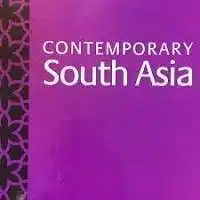
CONTEMPORARY SOUTH ASIA
Q.What is South Asia?
*Usually South Asia includes the countries of Indian sub-continent: India, Pakistan, Bangladesh, Nepal, Bhutan, Sri Lanka and the Maldives.
*Afghanistan and Myanmar are often included in discussions of the region as a whole.
*China is not considered the part of this region but it is an important player in this region.
Q.Democracy has become an established practice in South Asia’. Discuss.
* This region has a mixed record of democratic governments.
*While India and Sri Lanka have successfully practised democracy since their independence, Bangladesh and Pakistan have experienced both civilian and military rules at successive intervals.
*Nepal has transformed from a constitutional monarchy to a republic after a popular movement in 2006. Bhutan has also adopted a multi-party democracy with the king as a constitutional head.
* the Maldives has also transformed into a republic with the presidential form of government.
*A recent survey shows that there is widespread support for democracy in this region. People prefer democracy over any other form of government.
**Military and democracy in Pakistan:
*Since its formation, Pakistan has a mixed record of democracy. At successive intervals, military rulers have ruled the country overthrowing the democratic governments.
*After Pakistan framed its first constitution, General Ayub Khan captured power. He was succeeded by General Yahiya Khan.
*In 1971, an elected government, led by Zulfikar Ali Bhutto, came to power but he was also removed from power by General Zia-ul-Haq in 1977.
*Pakistan remained democratic between 1988 and 1999 but again General Parvez Musharraf captured power overthrowing the government of Nawaz Sharif.
Explain the factors responsible for the failure of democratic governments in Pakistan.
*Dominance of the military in the political field has led to the frequent overthrow of elected governments.
*Social dominance of clergy and the landowning class has also prevented the growth of democratic traditions.
*Pakistan’s conflict with India has also made pro-military groups more powerful.
*Lack of genuine international support for democratic rule is another factor. The USA and other western powers have encouraged authoritarian rule in Pakistan for their own vested interests i.e.USA needed allies in South Asia during cold-war and its war against global Islamic terrorism.
**Democracy in Bangladesh:
*Bangladesh was the part of Pakistan from 1947 to 1971. People of this region felt neglected and suppressed because of the following reasons:
*domination of West Pakistan,
*unfair treatment to their Bengali culture and imposition of Urdu language over them,
*inadequate representation in administration and political power,
*denial of regional autonomy to this region.
*refusal of the West Pakistani leadership to hand over power to Sheikh Mujibur Rehman whose party Awami League secured a majority of seats in the Central Assembly of Pakistan in the 1970 elections.
Q.Examine India’s role in the creation of Bangladesh.
*As the west Pakistani leadership refused to accept Sheik Mujib as the prime minister of Pakistan, a civil war broke out in East Pakistan.
*Pakistani army tried to suppress the mass movement.
*Millions of refugees crossed over the Indian border which created the huge problem for India.
*The government of India provided all possible help to the people of East Pakistan to get independence which resulted in a war between India and Pakistan in December 1971.
*Finally Pakistan surrendered and Bangladesh emerged as an independent nation.
*Like Pakistan, Bangladesh to has passed through successive military rules, but since 1990 the country has remained democratic.
**Monarchy and democracy in Nepal:
*Nepal was a Hindu kingdom, but in 1990 it became a constitutional monarchy.
*But the first phase of democratic government had a short and troubled career. In 2002 the new king of Nepal abolished the parliament and dismissed the government.
*In 2006 after countrywide pro-democracy protests led by Seven Party Alliance (SPA), the king agreed to restore the parliament and set up a constituent assembly to frame a new constitution for Nepal.
Q.What are the challenges before the democracy In Nepal?
* Nepal has become a republic but it is yet to draft a constitution acceptable to all the sections of the Nepalese people.
*With the recently adopted constitution, the Madhesi community is not happy and the country is passing through political conflict.
*Maoist insurgency has posed the serious threat to law and order.
*Some sections of Nepalese people want the monarchy to be restored.
Q.What are the causes of ethnic conflict in Sri Lanka?
* Though Sri Lanka has been successful in retaining its democratic structure since its independence in 1948 it has faced a serious ethnic conflict between the majority Sinhala community and the minority Tamils in the last three decades.
*Singles, the majority community, is hostile to a large number of Tamil migrants to Sri Lanka.
*They do not want the government to give any concession to the Tamils in jobs and education.
*Tamils want autonomy in northeastern areas and just representation in jobs and educational institutions.
*Denial of these demands led to an armed struggle by Tamils for a separate Tamil Elam since 1983.
Q.Examine India’s role in the ethnic conflict in Sri Lanka?
*As the Sri Lankan problem involves the people of Indian origin, therefore, the Indian government was under considerable pressure from the Tamil people in India to protect the interests of Tamils in Sri Lanka.
*The government of India signed an accord with the government of Sri Lanka in 1987 under which Indian peacekeeping forces were sent to Sri Lanka to solve the problem, but the Indian forces got into a fight with the LTTE.
*Even the Sri Lankans also did not like the presence of Indian troops in their country leading to the withdrawal of the IPKF in 1989 without solving the problem.
*The two Scandinavian countries Norway and Iceland are mediating between the warring groups to solve the problem.
**Indo-Pakistan relationship:
*Areas of conflict: *Kashmir issue: Since independence, it is the bone of contention between India and Pakistan. Being a Muslim majority area, Pakistan claims Kashmir as its legitimate part. Both the countries have fought three wars since 1947 but the issue has remained unsolved.
*Control of Siachen glacier: Both the countries have disagreements over the control of this glacier because of its strategic location.
*Other controversial issues between the two countries are cross-border terrorism, an arms race, sharing of the Indus water and the role of Pakistan’s spy agency ISI in abetting anti-India activities.
**Areas of cooperation: *Despite the conflict, Indus Water Treaty still survives.
*Trade between the two countries is expanding.
*Cultural exchange between the two countries is also going on despite political differences.
**Indo-Bangladesh relationship:
*Areas of conflict:* Differences over the sharing of Ganga and Brahmaputra river waters,
*Illegal immigration from Bangladesh to India and India’s decision to put barbed fences across the Indo-Bangladesh border.
*Bangladesh’s refusal to allow Indian troops to move through its territory to northeastern Indian states.
*Bangladesh also blames India of encouraging rebellion among the Chakmas in the Chittagong Hill Tracts of Bangladesh.
*Areas of cooperation: *Economic relationship between the two countries has improved considerably in the last two decades.
*Bangladesh is the part of India’s Look East Policy that wants to link up with Southeast Asia via Myanmar.
**India and other neighbours: *Indo Nepal relationship: Nepal and India enjoy a special relationship. Indo Nepal Treaty allows the people of two countries to visit and work in each other’s territory without visa and passport.
* Trade and Transit treaty between the two countries gives Nepal access to seaports.
*But India has also shown displeasure over the growing relationship between Nepal and China and Nepal government’s inaction against anti- Indian elements.
*Nevertheless Indo-Nepal relationship has remained fairly stable.
*India and Sri Lanka have a disagreement over the ethnic conflict in the island nation.
*After the exit of IPKF from Sri Lanka in 2001, India has adopted the policy of disengagement in this country.
*Despite political differences trade between the two countries is expanding.
*Indo-Bhutan relationship is very smooth and cordial. India is helping Bhutan in developing hydroelectricity projects and is the biggest source of economic aid to it.
*India is also helping the Maldives in developing tourism and fisheries.
*In 1988 India helped the Maldives in repulsing a foreign mercenary attack.
**Objectives of SAARC: South Asian Association for Regional Cooperation (SAARC) was formed in 1985 with the following objectives:
*to evolve cooperation among the member states through multilateral means,
*to promote free trade in the region,
*to promote harmony in the region through cultural exchanges,
*to promote in a better way on political issues to maintain peace in the region
**SAFTA: To promote free trade in the region, members of SAARC Signed South Asian Free Trade Agreement (SAFTA) which came in to effect on January 1, 2006?
**Limitations of SAARC: SAARC has not been as successful as ASEAN or EU because many member states feel that SAARC or SAFTA is a way for India to invade their market.
*Given its vast size and power, India’s neighbours are bound to be suspicious of India’s intentions.
*They also feel that India can influence their society and politics through commercial ventures.
*They fear that India wants to be a regionally dominant power.
Q.How are Foreign powers influencing bilateral relations in South Asian politics?
* US and China are the key players in this region.
*Though Sino-Indian relationship has improved in the past, China’s strategic partnership with Pakistan remains a major irritant in Indo-Pakistan and Indo-China relationship.
*US involvement in the region has increased since the end of the cold war. Now the US is trying to develop a friendly relationship with both India and Pakistan.
*A large South Asian Diaspora and large market of the region, gives the US an added stake in the future of regional security and peace.
Download the above article in PDF
Want to Read More:-
51.LIFE SKILLS— An Important Subject to Study
54.High-Tech Device—Boon or Bane
55.Indian TV in the Service of General Public
56.Impact of Continuing Destruction of Wildlife
57.A National Integration Camp
